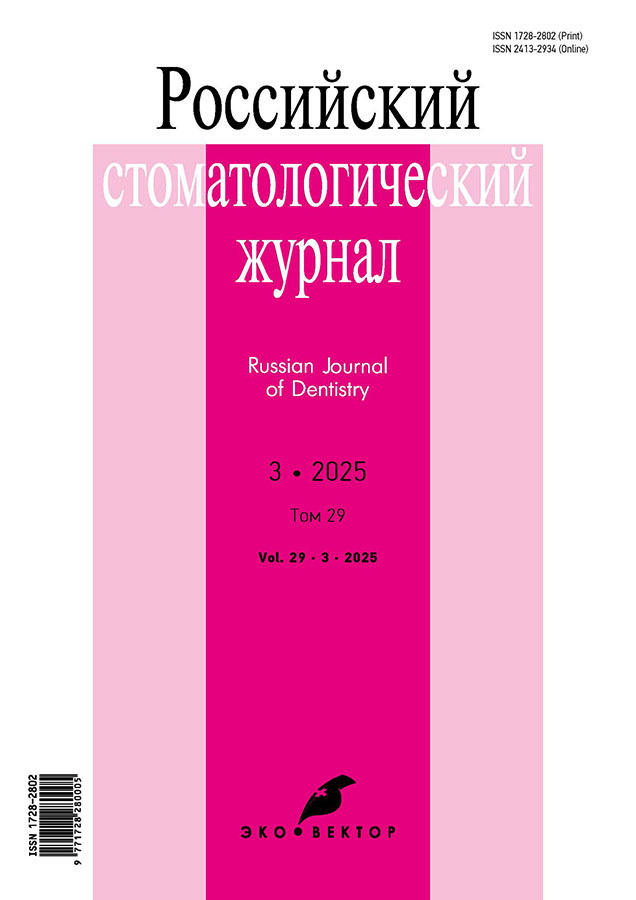Efficacy of Erbium Laser Therapy in Management of Peri-Implantitis: Findings of a Clinical Observation
- Authors: Sokolov M.V.1,2, Furtsev T.V.1,2
-
Affiliations:
- Professor Voino-Yasenetsky Krasnoyarsk State Medical University
- Medident Medical, Scientific, Training and Production Centre
- Issue: Vol 29, No 3 (2025)
- Pages: 290-296
- Section: Case reports
- Submitted: 02.04.2025
- Accepted: 28.04.2025
- Published: 27.06.2025
- URL: https://rjdentistry.com/1728-2802/article/view/678045
- DOI: https://doi.org/10.17816/dent678045
- EDN: https://elibrary.ru/COXYNQ
- ID: 678045
Cite item
Abstract
BACKGROUND: Peri-implantitis, frequently resulting from bacterial biofilm formation on implant surfaces, is a leading cause of dental implant failure. This underscores the relevance of developing and implementing effective decontamination methods that remove biofilm while preserving implant integrity and surrounding tissue.
CLINICAL CASE DESCRIPTION: This report presents a clinical case involving a 54-year-old patient with peri-implantitis at site 4.2. The treatment approach was tailored to the implant surface type and involved an Er,Cr:YSGG erbium laser (Biolase, USA) with a wavelength of 2780 nm. Laser irradiation of the anodized titanium dioxide (TiO2) implant surface enabled efficient removal of granulation tissue and bacterial biofilm without damaging adjacent tissues and promoted subsequent regeneration. A large area of bone resorption was grafted with a xenogenic bone substitute and covered with a collagen membrane.
Clinical and radiographic evaluation at 6-month follow-up demonstrated stable bone levels and absence of inflammation.
CONCLUSION: This clinical case demonstrates the high efficacy of the Er,Cr:YSGG laser as part of comprehensive peri-implantitis management, providing atraumatic and effective implant surface decontamination while promoting bone regeneration.
Keywords
Full Text
About the authors
Maxim V. Sokolov
Professor Voino-Yasenetsky Krasnoyarsk State Medical University; Medident Medical, Scientific, Training and Production Centre
Email: maks_sokoloff@mail.ru
ORCID iD: 0009-0006-1457-105X
SPIN-code: 6431-7845
Russian Federation, Krasnoyarsk; Krasnoyarsk
Taras V. Furtsev
Professor Voino-Yasenetsky Krasnoyarsk State Medical University; Medident Medical, Scientific, Training and Production Centre
Author for correspondence.
Email: taras.furtsev@gmail.com
ORCID iD: 0000-0002-5300-9274
SPIN-code: 7108-0928
MD, Dr. Sci. (Medicine), Professor
Russian Federation, Krasnoyarsk; KrasnoyarskReferences
- Berglundh T, Armitage G, Araujo MG, et al. Peri-implant diseases and conditions: Consensus report of workgroup 4 of the 2017 World Workshop on the Classification of Periodontal and Peri-Implant Diseases and Conditions. J Clin Periodontol. 2018;45(Suppl. 20):S286–S291. doi: 10.1111/jcpe.12957
- Derks J, Schaller D, Håkansson J, et al. Peri-implantitis — onset and pattern of progression. J Clin Periodontol. 2016;43(4):383–388. doi: 10.1111/jcpe.12535
- Cha JK, Lee JS, Kim CS. Surgical therapy of peri-implantitis with local minocycline: A 6-month randomized controlled clinical trial. J Dent Res. 2019;98(3):288–295. doi: 10.1177/0022034518818479
- Daubert DM, Weinstein BF. Biofilm as a risk factor in implant treatment. Periodontol 2000. 2019;81(1):29–40. doi: 10.1111/prd.12280
- Elnagdy S, Raptopoulos M, Kormas I, et al. Local oral delivery agents with anti-biofilm properties for the treatment of periodontitis and peri-implantitis. A narrative review. Molecules. 2021;26(18):5661. doi: 10.3390/molecules26185661 EDN: CDXYKS
- Hentenaar DFM, De Waal YCM, Stewart RE, et al. Erythritol airpolishing in the non-surgical treatment of peri-implantitis: A randomized controlled trial. Clin Oral Implants Res. 2021;32(7):840–852. doi: 10.1111/clr.13757 EDN: IBKMNB
- Mattar H, Bahgat M, Ezzat A, et al. Management of peri-implantitis using a diode laser (810 nm) vs conventional treatment: a systematic review. Lasers Med Sci. 2021;36(1):13–23. doi: 10.1007/s10103-020-03108-w EDN: OJSPON
- Furtsev TV, Zeer GM. Comparative research of implants with three types of surface processing (TiUnite, SLA, RBM), control, with periimplantitis and processed by 2780 nm Er;Cr;YSGG laser. Stomatologiia (Mosk). 2019;98(3):52–55. doi: 10.17116/stomat20199803152 EDN: JRSKZJ
- Furtsev TV, Savchenko AA, Sokolov MV, Gvozdev II. Effect of periimplantitis treatment on the chemiluminescent activity of neutrophilic granulocytes in vitro. Russian Journal of Dentistry. 2024;28(6):543–554. doi: 10.17816/dent633838 EDN: CEIWAG
- Jung S, Bohner L, Hanisch M, et al. Influence of implant material and surface on mode and strength of cell/matrix attachment of human adipose derived stromal cell. Int J Mol Sci. 2020;21(11):4110. doi: 10.3390/ijms21114110 EDN: ZTWMQZ
Supplementary files

















